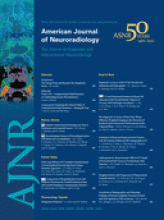Thank you for your interest in our article “Interpretation Errors in CT Angiography of the Head and Neck and the Benefit of Double Reading.”1 We discuss each of your questions as numbered.
1) We agree that the phenomenon of “satisfaction of search” can be responsible for perceptual errors in radiology. We reassessed our data to determine how many of the misses were in the setting of a correctly detected major abnormality that explained the presenting complaint. There were 8 misses on 7 studies in which “satisfaction of search” may have played a role.
2) Vessel occlusions and stenoses were only considered a significant miss in the setting of stroke. Therefore, none of these misses occurred in the setting of hemorrhage. Of the 13 missed aneurysms, 7 were missed when the presenting history was rule out aneurysm. The other 6 had presenting complaints of stroke (n = 1), vasculitis (n = 1), stenosis (n = 3), and vascular injury (n = 1).
3) For the complete head and neck CTA studies, there were 13 misses on 11 studies. For the intracranial-only CTA studies, there were 13 misses on 9 studies. The difference was not statistically significant.
4) There were 5 misses on 3 studies that occurred on call. There were 21 misses on 17 studies that occurred during regular work hours. The miss rate was not higher on call compared with regular work hours.
5) The mean age of patients with misses was 65 ± 15 years. The mean age of patients without misses was 60 ± 19 years. The difference was not statistically significant.
6) Only findings that we believe required follow-up, were pertinent to the presenting symptom, or required immediate intervention were defined as “significant. ” Examples of minor discrepancies included stenoses unrelated to the presenting symptom and degenerative changes. We included all missed aneurysms, even if the presenting symptom was not subarachnoid hemorrhage, because it was judged that these would require follow-up. Arguably some of these may not be significant.
7) The distribution of errors was not equivalent among all of the radiologists, but the difference was not statistically significant. The least experienced radiologist had 5 misses on 4 studies. The second least experienced radiologist had 4 misses on 3 studies. The most experienced radiologist had 6 misses on 5 studies. The second most experienced radiologist had 11 misses on 8 studies. The middle radiologist in terms of experience had no misses. He worked only part-time at the time of the study and reported the fewest number of studies.
Reference
- 1.↵
- © 2012 by American Journal of Neuroradiology







